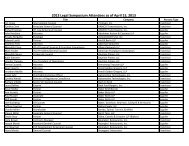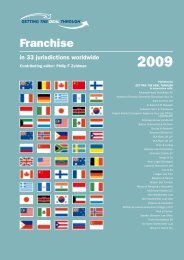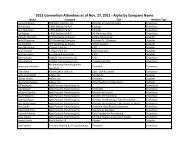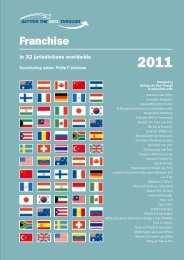South Africa - International Franchise Association
South Africa - International Franchise Association
South Africa - International Franchise Association
You also want an ePaper? Increase the reach of your titles
YUMPU automatically turns print PDFs into web optimized ePapers that Google loves.
Meanwhile, a significant pipeline of private power projects exists.<br />
Demand-focused Initiatives<br />
To relieve pressure on the generation system in the short-term, the government has also<br />
been trying to reduce demand. Demand side management is recognized in the IRP2010<br />
document, which cites energy efficiency as an important contributing factor to the overall<br />
energy system in <strong>South</strong> <strong>Africa</strong>, and projects a savings level of 3 420 MW by 2030.<br />
It is expected that the National Energy Efficiency Agency (NEEA), under the rearranged<br />
<strong>South</strong> <strong>Africa</strong>n National Energy Development Institute, will lead the way on energy<br />
efficiency projects.<br />
Meanwhile, Eskom has been authorized by the National Energy Regulator of <strong>South</strong><br />
<strong>Africa</strong> (NERSA), through the multiyear price determination (MYPD), to fund DSM efforts<br />
to the value of $761 million (R5.45 billion) over the MYPD period from 2010 to 2013.<br />
A component of the demand response program could involve the deployment of<br />
residential demand-management solutions, using either smart metering or Eskom’s socalled<br />
‘utility load manager’, which would enable it to remotely switch off key energyconsuming<br />
appliances.<br />
Electricity Distribution<br />
In addition to the threat of electricity supply disruptions owing to inadequate generation<br />
capacity, the security of electricity supply in <strong>South</strong> <strong>Africa</strong> is threatened by the dilapidated<br />
state of the country’s electricity distribution industry (EDI).<br />
Electricity distribution in <strong>South</strong> <strong>Africa</strong> is the responsibility of Eskom and 187<br />
municipalities. The municipalities account for about 40% of total electricity sales and<br />
about 60% of the customer base. About one-third of the 187 municipal distributors are<br />
currently experiencing severe financial problems and many, particularly those in lowincome<br />
areas, owe large sums of money to Eskom.<br />
The maintenance backlog in the sector is valued at between $3.91 billion (R28-billion)<br />
and $4.46 billion (R32-billion), and is growing at a rate of about $349 million (R2.5<br />
billion) a year.<br />
A special purpose vehicle is set to be established to accelerate and improve the<br />
provision of municipal infrastructure generally, and the DoE will be the principal<br />
department to police the maintenance and upgrading of electricity distribution<br />
infrastructure.<br />
Opportunities Return to top<br />
The future generation plan, premised on the IRP2010 document, will see power capacity<br />
expanded to 89 532 MW by 2030. According to the plan, this will include the introduction<br />
of 56 539 MW of new capacity, and the decommissioning of 10 902 MW of older<br />
capacity. Of the new capacity awaited, a small portion, some 14 000 MW, falls within the<br />
‘committed build’ category, while details on the projects that will provide the balance of<br />
the new capacity are still to be finalized.
















